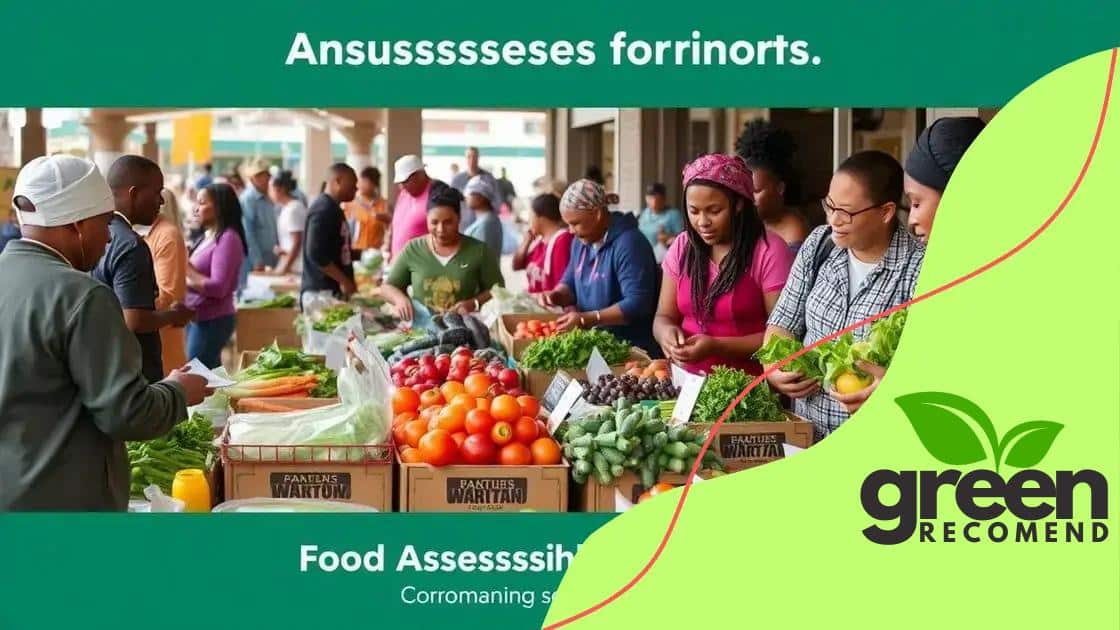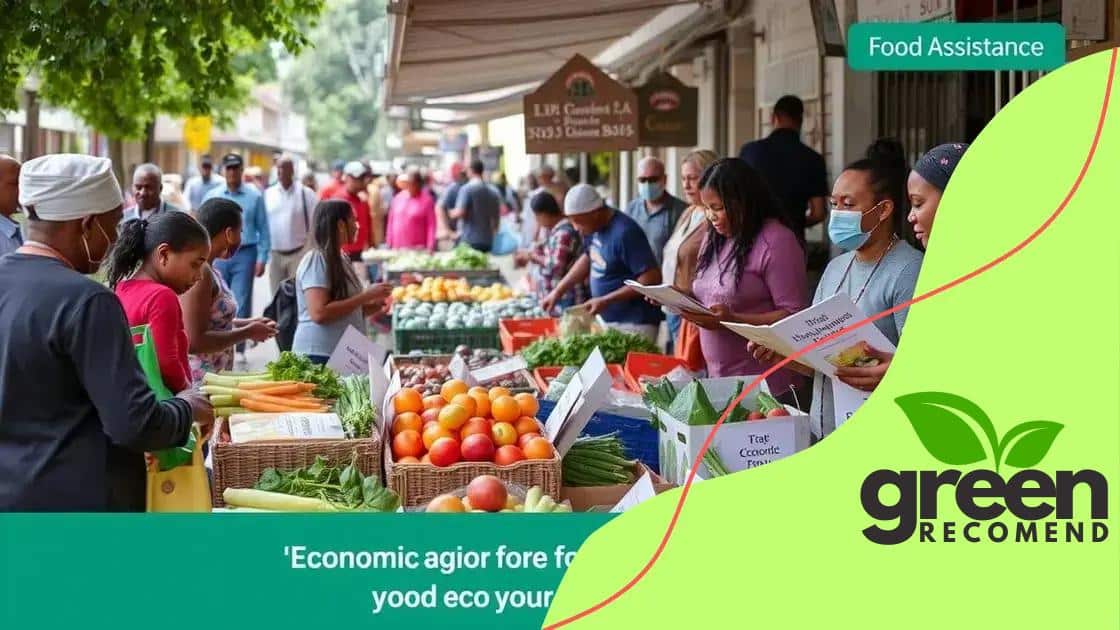Growth of food assistance programs in global markets

The growth of food assistance programs in global markets focuses on improving food security through technological innovations, community engagement, and sustainable practices, effectively addressing hunger and supporting local economies.
Growth of food assistance programs in global markets is more than just a response to hunger—it’s a crucial lifeline for millions. Have you ever wondered how these initiatives shape communities and economies around the world?
Understanding food assistance programs
Understanding food assistance programs is vital in today’s world, as they play a critical role in combating hunger and supporting communities. These programs help ensure that families have access to nutritious food, especially in times of crisis.
There are various types of food assistance programs that cater to different needs. One of the most recognized initiatives is the Supplemental Nutrition Assistance Program (SNAP), which provides financial aid to low-income families. Additionally, food banks and local charities work tirelessly to distribute food to those in need.
Types of Food Assistance Programs
Food assistance comes in several forms:
- Government Programs: These include SNAP and Women, Infants, and Children (WIC).
- Community Initiatives: Local organizations often run food drives and soup kitchens.
- School Meal Programs: Many schools provide free meals to students from low-income families.
These programs are essential for promoting food security and improving overall health in communities. They help bridge the gap for millions who struggle to afford basic necessities.
Another critical aspect is the collaboration between government agencies and non-profits, which creates more effective solutions for distributing food to those who need it most. This cooperative effort ensures that food reaches every corner of society and addresses the unique challenges faced by different populations.
The global landscape of food shortages
The global landscape of food shortages is a growing concern that impacts millions of people everyday. Various factors contribute to this issue, making it essential to understand the broader implications.
One major cause is climate change, which disrupts agricultural production. Natural disasters, like floods and droughts, can destroy crops and lead to significant shortages. Additionally, economic instability in certain regions further complicates food access, forcing many families to go without essential nutrients.
Key Factors Contributing to Food Shortages
Food shortages arise from multiple intertwined causes:
- Economic Challenges: High food prices can make it difficult for families to afford adequate nutrition.
- Conflict and Instability: Wars and disputes disrupt food production and distribution.
- Agricultural Practices: Sustainable farming practices are not widely adopted, impacting crop yields.
Moreover, as the world population continues to grow, the demand for food increases, putting additional pressure on resources. Countries struggling with food shortages often find themselves trapped in a cycle of poverty and hunger.
Addressing these complex issues requires global cooperation and innovative solutions. For example, investing in technology can help improve crop resilience and ensure better food distribution systems. Education on sustainable practices can empower farmers and enhance food security.
Impact on local economies

The impact of food assistance programs on local economies is significant and wide-ranging. These programs not only provide essential food but also stimulate economic activity in various ways.
When individuals receive food assistance, they have more disposable income to spend on other necessities. This shift in spending can boost local businesses, as families buy groceries, clothing, and participate in community activities.
Benefits of Food Assistance to Local Economies
Food assistance programs deliver multiple economic benefits:
- Job Creation: Programs often involve local distribution centers that hire staff, creating job opportunities.
- Increased Consumer Spending: As families save money on food, they can spend more in local shops.
- Support for Farmers: Programs can purchase food from local farmers, helping to sustain agricultural communities.
These benefits create a ripple effect, fostering community resilience and enhancing overall economic stability. Additionally, food assistance can improve the productivity of communities by ensuring individuals have access to proper nutrition. Healthy citizens are more capable of participating in the workforce and contributing to their local economy.
Furthermore, local governments often benefit from reduced healthcare costs due to improved public health resulting from better nutrition. Overall, food assistance serves as a vital tool in lifting local economies and promoting community development.
Innovations in food distribution
Innovations in food distribution are crucial for improving access to food assistance programs. These advancements help streamline the process and ensure that nutritious food reaches those in need quickly and efficiently.
One key innovation is the use of technology, such as mobile apps and online platforms, which connect food donors with local food banks. These tools allow for real-time sharing of surplus food, reducing waste while providing essential resources to communities.
Technological Innovations
Here are some important technologies that enhance food distribution:
- Mobile Food Pantries: These trucks deliver food directly to communities in need, reducing barriers to access.
- Data Analytics: Advanced data systems help predict food needs in different areas, improving supply chain efficiency.
- Blockchain Technology: This ensures transparency in the supply chain, helping to track food sources and minimize theft.
In addition, partnerships between local organizations and tech companies have led to creative solutions. For example, community-supported agriculture (CSA) models allow consumers to buy directly from local farmers, enhancing food security while supporting local economies.
Furthermore, innovations in packaging also play a significant role. Eco-friendly packaging can keep food fresh longer, reducing spoilage and waste. By adopting these innovative practices, food assistance programs can better address the growing challenges posed by food insecurity.
Future trends in food assistance
Future trends in food assistance programs are evolving to meet the changing needs of communities. As challenges related to food security grow, these programs are adapting and integrating new approaches to enhance their impact.
One emerging trend is the focus on sustainability. Programs are increasingly prioritizing local sourcing and reducing food waste. This shift not only supports local farmers but also ensures that communities have access to fresh and nutritious food.
Key Trends Shaping Food Assistance
Several trends are expected to influence the future of food assistance:
- Technology Integration: The use of apps and platforms to streamline food distribution and connect volunteers will continue to rise.
- Personalized Nutrition: Programs may start offering tailored food options based on individual dietary needs and preferences.
- Community Engagement: Building partnerships with local organizations will enhance the effectiveness of food assistance initiatives.
Alongside these trends, there is also a growing emphasis on education. Many programs are now providing resources on cooking and nutrition to empower recipients. This education can lead to healthier eating habits and improved food choices.
Another exciting area is the potential for policy changes that further support food assistance. Advocates are working for increased funding and more comprehensive programs to better address food insecurity. By fostering these changes, communities can build a stronger foundation for future food security.
The future of food assistance programs holds great promise for enhancing food security and community well-being. By integrating innovative technologies, local sourcing, and educational initiatives, these programs can better serve those in need. Emphasizing sustainability and creating community partnerships will further strengthen the impact of food assistance. As these trends continue to evolve, they will empower individuals and communities to become healthier and more self-sufficient.
FAQ – Frequently Asked Questions about Food Assistance Programs
What role does technology play in food assistance?
Technology helps streamline food distribution, connect donors with food banks, and improve access to resources for those in need.
How can food assistance programs promote sustainability?
These programs prioritize local sourcing and reduce food waste, ensuring access to fresh and nutritious food while supporting local economies.
What is the importance of community engagement in food assistance?
Building partnerships with local organizations enhances program effectiveness and ensures that assistance meets the specific needs of the community.
Why is education included in food assistance initiatives?
Education on cooking and nutrition empowers individuals to make healthier food choices and improves overall community health.





